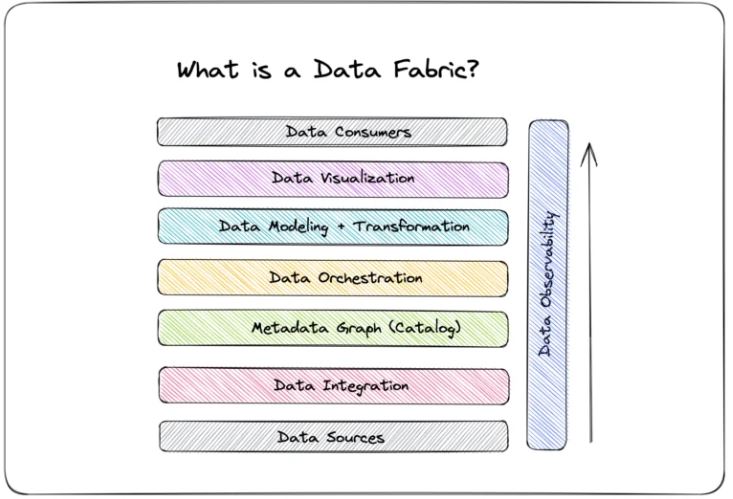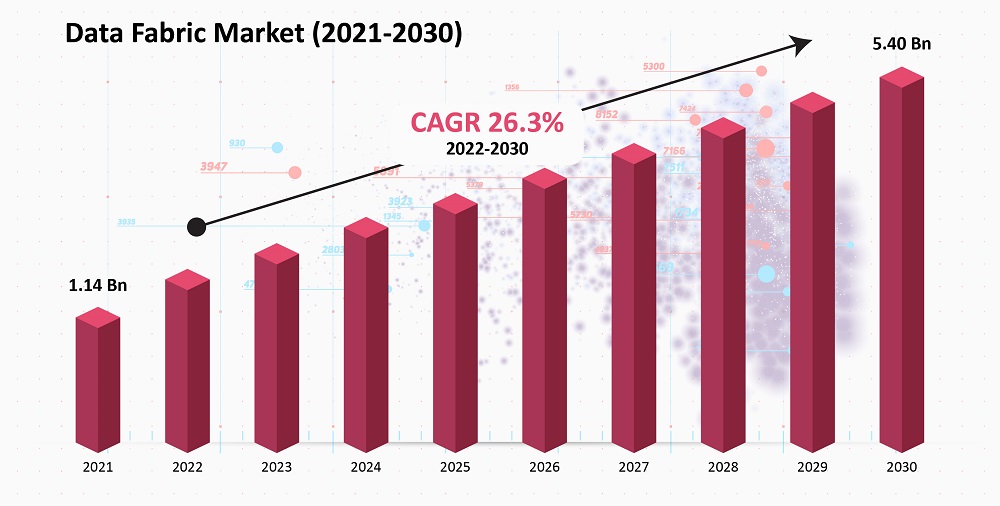Data Fabric: Latest Trends and Developments in the Global Market
A Comprehensive Guide to Data Fabric: Is Your Business Data-Ready?
In today’s dynamic business landscape, customer interactions occur across diverse touchpoints, resulting in data scattered across hybrid cloud environments, databases, CRM systems, and various applications. This dispersion of data poses challenges in managing and accessing information efficiently. This is where”data fabric” comes in – a virtual, central management layer that serves as an abstracted data management platform.
Designed to streamline and unify data management and access within an organization, a data fabric has evolved into an indispensable component for businesses. This is reflected in projections indicating that the data fabric market is foreseen to progress at a compound annual growth rate (CAGR) of 26.3% to reach $5.4 billion in revenue by 2030.
This blog highlights the significance of data-centralized architecture, its functionalities, and the transformative impact it can have on organizational data management strategies. Let’s dive in!
What is a Data Fabric?
Data fabric is an advanced data integration framework that harnesses metadata resources to consolidate, integrate, and control diverse data ecosystems. Through the standardization, interconnection, and automation of data management methods and procedures, it enhances data security and availability and facilitates seamless integration of data pipelines across various platforms including on-premises, cloud, hybrid multi-cloud, and edge devices.
Why Should Your Business Invest in a Data Fabric?
In the realm of data management, complexity arises from the constant influx of new technologies, data types, and platforms. Adapting and fortifying data management methods with each technological shift is a formidable task. However, as technology advances at a rapid pace, conventional approaches to data management become insufficient and impractical.
This data integration framework can be an effective solution for navigating and minimizing the impact of rapid technological changes. Its versatile capabilities enable the development of a robust data management strategy that incorporates augmented data integration.
This architecture is impartial and functions across various deployment platforms and with diverse data processing techniques. Its purpose is to simplify the utilization of data as a valuable resource by eliminating complexity. Furthermore, it allows for the integration, retrieval, sharing, and management of any data from any location on any platform.
Benefits of Data Fabric
The Forrester New Technology: Projected Total Economic Impact 2020 study highlights the significant business value of a unified data fabric architecture, as exemplified by the IBM Cloud Pak for Data:
- A remarkable 459% increase in Returns on Investment
- Average business benefits totaling $5.8 million
- Facilitated 60X faster data delivery
- 20X speedier analysis of customer affinity
While these figures are specific to the IBM Cloud Pak for Data, converged data capabilities are universally applicable to organizations operating in multi-cloud environments.
Implementing this architecture yields cost reductions and enhanced productivity, leading to quicker time-to-value:
- Facilitates rapid access to trusted data, minimizing data silos and expediting self-service data discovery and analytics.
- Automates data engineering tasks and enhances data integration, providing real-time insights.
- Utilizes active metadata to elevate data quality, curation, classification, policy enforcement, and more.
- Prepares jobs for diverse environments and varying data volumes through automated workload orchestration.
- Enables consumers to effortlessly locate, comprehend, and trust data through automated data discovery and enrichment.
Components of Data Fabric
In order to enhance your comprehension of how data fabric can enhance the accessibility and reliability of data, let’s delve into its various essential components.
Data integration and orchestration effectively combine information from various origins, facilitating effortless exchange and harmonization.
Metadata management and governance ensure the maintenance of extensive metadata to facilitate efficient organization, exploration, and adherence to regulatory norms.
The unified access and storage layer offers a singular interface to retrieve different categories of data that are stored in multiple locations.
Data security and privacy encompass stringent security measures and privacy controls that guarantee the protection of your data while adhering to applicable regulations.
Real-time analytics and reporting provide the ability to gain immediate insights from data by utilizing real-time analytics and extensive reporting functionality.
The data integration framework is a comprehensive solution that brings together various processes to optimize data integration, improve metadata management and governance, and establish a centralized access and storage system. Incorporating these essential components can significantly transform the way organizations manage their expanding data quantities.
Future Trends in Data Fabric
As cloud computing continues to gain traction, the potential of data fabric is expanding rapidly. Listed below are some upcoming trends in the realm of centralized data architecture.
➢ Integration of Artificial Intelligence & Machine Learning
The integration of AI and machine learning (ML) will revolutionize the perspective and management of data within organizations.
By integrating artificial intelligence (AI) and machine learning (ML) algorithms into data fabric technologies, organizations can leverage advanced predictive analytics, automate data processing and analysis, and make real-time decisions. This integration facilitates quicker access to insights, enhances prediction accuracy, and increases the effectiveness of handling extensive data sets.
- With the implementation of improved predictive analytics capabilities, businesses can enhance their ability to make precise forecasts by analyzing past patterns and trends more effectively.
- Automated data processing and analysis enhance the management of large volumes of data, minimizing manual labor and ensuring precise results.
- Real-time decision-making enables organizations to swiftly adapt to changing situations by utilizing AI-generated knowledge to take prompt action.
- This architecture plays a crucial role in offering businesses a comprehensive understanding of their data, enabling them to extract valuable insights and make well-informed strategic decisions.
➢ Expansion of Edge Computing
The growth of edge computing is primarily fueled by the advantages it offers in terms of reduced latency, improved scalability, and increased security. This technology brings data-intensive applications closer to end-users, minimizing latency and enabling real-time processing.
The decentralized aspect of edge computing also allows for improved scalability and efficiency at the network’s periphery, guaranteeing smooth functioning even during times of high usage.
Edge data fabric allows organizations to leverage the full potential of edge computing, enabling them to optimize their digital infrastructure for various use cases. This technology presents numerous advantages, empowering businesses to effectively utilize edge computing and its capabilities. By integrating edge data fabric into their systems, organizations can maximize the benefits and achieve optimal performance in their operations.
➢ Automated Data Governance
Data governance plays a crucial role in the unified environment and is gaining prominence as organizations strive to uphold the integrity, precision, and security of their data. The implementation of automated data governance procedures can contribute to regulatory compliance and adherence to industry benchmarks, while also delivering a comprehensive understanding of the organization’s data infrastructure.
Data Fabric Case Study: BMC’s Transformation of Complex Technology
BMC Software is dedicated to enhancing global companies’ delivery and consumption of digital services. Faced with decentralized and manual processes in accounts payable and generic ledger operations, BMC collaborated with Informatica to swiftly establish a functional system. This enabled the implementation of advanced capabilities for enhanced visibility into actual and projected cash flows, resulting in substantial cost savings, improved reporting, and superior control across hundreds of bank accounts. The accurate visibility achieved has empowered BMC to implement more effective risk management and mitigation strategies.
Through the collaboration with Informatica, BMC transformed its operational landscape, saving significant costs, achieving precise visibility, and optimizing its working capital. The streamlined processes have not only allowed for better reporting and control but also facilitated improved risk management strategies.
To Conclude
The emergence of data fabric as a revolutionary solution in the constantly changing field of data management offers organizations a comprehensive and adaptable approach to handling their data. Its seamless integration, connection, and orchestration of diverse data sources enable businesses to break down silos, promote collaboration, gain valuable insights, make informed decisions, and foster innovation. In today’s data-driven society, the adoption of this framework is no longer a mere option but a crucial strategic move for individuals and organizations looking to leverage the maximum value from their data resources.
Author Bio: The post is by Alisha Patil, a budding writer and a bibliophile by nature, Alisha has been honing her skills in market research and the B2B domain for a while now. She writes on topics that deal with innovation, technology, and the captivating world of business. An MBA holder in marketing, she takes on every challenge that comes her way with much enthusiasm and zeal. When not working, she loves to read or sketch. You can follow her on LinkedIn.




























